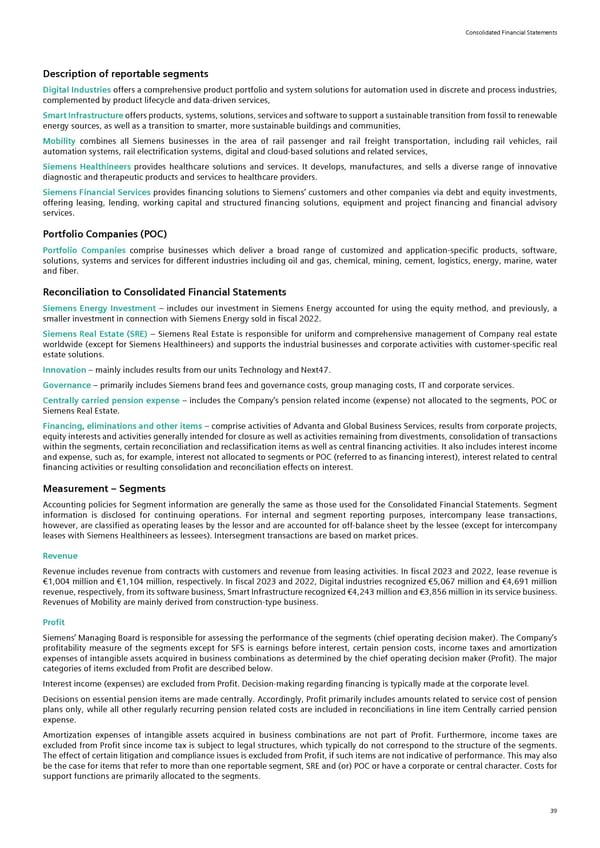Consolidated Financial Statements Description of reportable segments Digital Industries offers a comprehensive product portfolio and system solutions for automation used in discrete and process industries, complemented by product lifecycle and data-driven services, Smart Infrastructure offers products, systems, solutions, services and software to support a sustainable transition from fossil to renewable energy sources, as well as a transition to smarter, more sustainable buildings and communities, Mobility combines all Siemens businesses in the area of rail passenger and rail freight transportation, including rail vehicles, rail automation systems, rail electrification systems, digital and cloud-based solutions and related services, Siemens Healthineers provides healthcare solutions and services. It develops, manufactures, and sells a diverse range of innovative diagnostic and therapeutic products and services to healthcare providers. Siemens Financial Services provides financing solutions to Siemens’ customers and other companies via debt and equity investments, offering leasing, lending, working capital and structured financing solutions, equipment and project financing and financial advisory services. Portfolio Companies (POC) Portfolio Companies comprise businesses which deliver a broad range of customized and application-specific products, software, solutions, systems and services for different industries including oil and gas, chemical, mining, cement, logistics, energy, marine, water and fiber. Reconciliation to Consolidated Financial Statements Siemens Energy Investment – includes our investment in Siemens Energy accounted for using the equity method, and previously, a smaller investment in connection with Siemens Energy sold in fiscal 2022. Siemens Real Estate (SRE) – Siemens Real Estate is responsible for uniform and comprehensive management of Company real estate worldwide (except for Siemens Healthineers) and supports the industrial businesses and corporate activities with customer-specific real estate solutions. Innovation – mainly includes results from our units Technology and Next47. Governance – primarily includes Siemens brand fees and governance costs, group managing costs, IT and corporate services. Centrally carried pension expense – includes the Company’s pension related income (expense) not allocated to the segments, POC or Siemens Real Estate. Financing, eliminations and other items – comprise activities of Advanta and Global Business Services, results from corporate projects, equity interests and activities generally intended for closure as well as activities remaining from divestments, consolidation of transactions within the segments, certain reconciliation and reclassification items as well as central financing activities. It also includes interest income and expense, such as, for example, interest not allocated to segments or POC (referred to as financing interest), interest related to central financing activities or resulting consolidation and reconciliation effects on interest. Measurement – Segments Accounting policies for Segment information are generally the same as those used for the Consolidated Financial Statements. Segment information is disclosed for continuing operations. For internal and segment reporting purposes, intercompany lease transactions, however, are classified as operating leases by the lessor and are accounted for off-balance sheet by the lessee (except for intercompany leases with Siemens Healthineers as lessees). Intersegment transactions are based on market prices. Revenue Revenue includes revenue from contracts with customers and revenue from leasing activities. In fiscal 2023 and 2022, lease revenue is €1,004 million and €1,104 million, respectively. In fiscal 2023 and 2022, Digital industries recognized €5,067 million and €4,691 million revenue, respectively, from its software business, Smart Infrastructure recognized €4,243 million and €3,856 million in its service business. Revenues of Mobility are mainly derived from construction-type business. Profit Siemens’ Managing Board is responsible for assessing the performance of the segments (chief operating decision maker). The Company’s profitability measure of the segments except for SFS is earnings before interest, certain pension costs, income taxes and amortization expenses of intangible assets acquired in business combinations as determined by the chief operating decision maker (Profit). The major categories of items excluded from Profit are described below. Interest income (expenses) are excluded from Profit. Decision-making regarding financing is typically made at the corporate level. Decisions on essential pension items are made centrally. Accordingly, Profit primarily includes amounts related to service cost of pension plans only, while all other regularly recurring pension related costs are included in reconciliations in line item Centrally carried pension expense. Amortization expenses of intangible assets acquired in business combinations are not part of Profit. Furthermore, income taxes are excluded from Profit since income tax is subject to legal structures, which typically do not correspond to the structure of the segments. The effect of certain litigation and compliance issues is excluded from Profit, if such items are not indicative of performance. This may also be the case for items that refer to more than one reportable segment, SRE and (or) POC or have a corporate or central character. Costs for support functions are primarily allocated to the segments. 39
 Siemens Report FY2023 Page 84 Page 86
Siemens Report FY2023 Page 84 Page 86